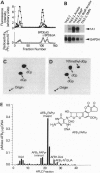Abstract
Normal human liver tissue and cultured human hepatocytes are valuable models to study xenobiotic metabolism and toxicity, but they only have a limited in vitro life-span and are not readily available. This report describes the establishment of replicative cultures of human adult liver epithelial cells in serum-free medium. The longevity of three of these cultures, derived from different donors, was extended by introduction of the simian virus 40 large T antigen gene. Two cell lines, THLE-2 and -3, established with a recombinant simian virus 40 large T antigen virus have undergone > 100 population doublings, are nontumorigenic when injected into athymic nude mice, have near-diploid karyotypes, and do not express alpha-fetoprotein. The cells express cytokeratin 18 and albumin in early passage, whereas higher-passage cells in logarithmic-phase growth also express cytokeratin 19. THLE-2 and -3 cells metabolize benzo[a]pyrene, N-nitrosodimethylamine, and aflatoxin B1 to their ultimate carcinogenic metabolites that adduct DNA, which indicates functional cytochrome P450 pathways. Other enzymes involved in metabolism of chemical carcinogens, such as epoxide hydrolase, NADPH cytochrome P450 reductase, superoxide dismutase, catalase, glutathione S-transferases, and glutathione peroxidase are also retained by THLE cells. Thus, these immortalized human liver cells constitute an in vitro model for pharmacotoxicological studies and for the investigation of etiology and pathogenesis of human hepatocellular carcinoma.
Full text
PDF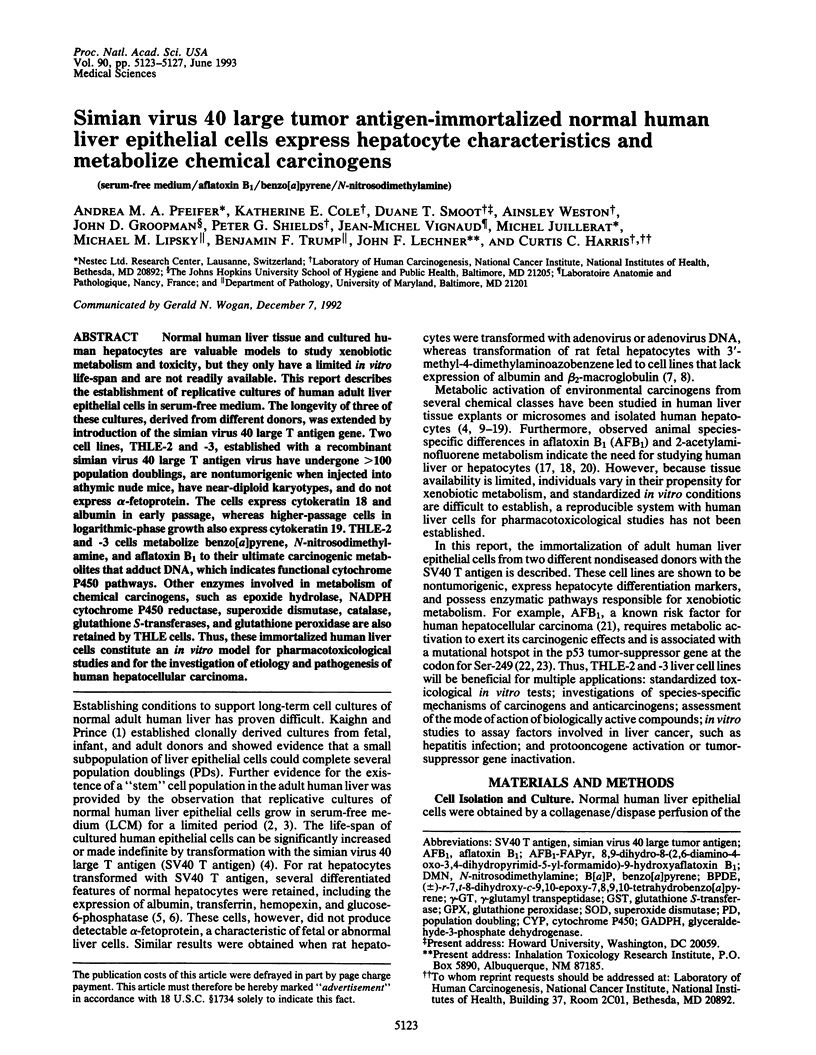
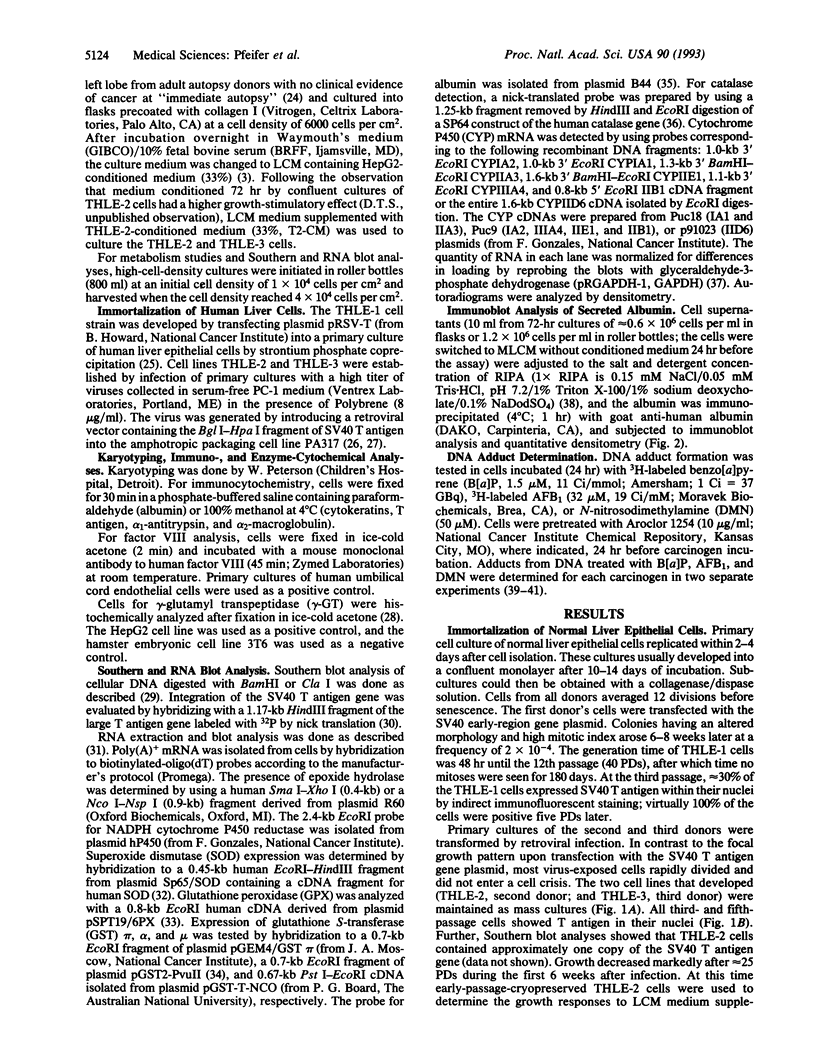

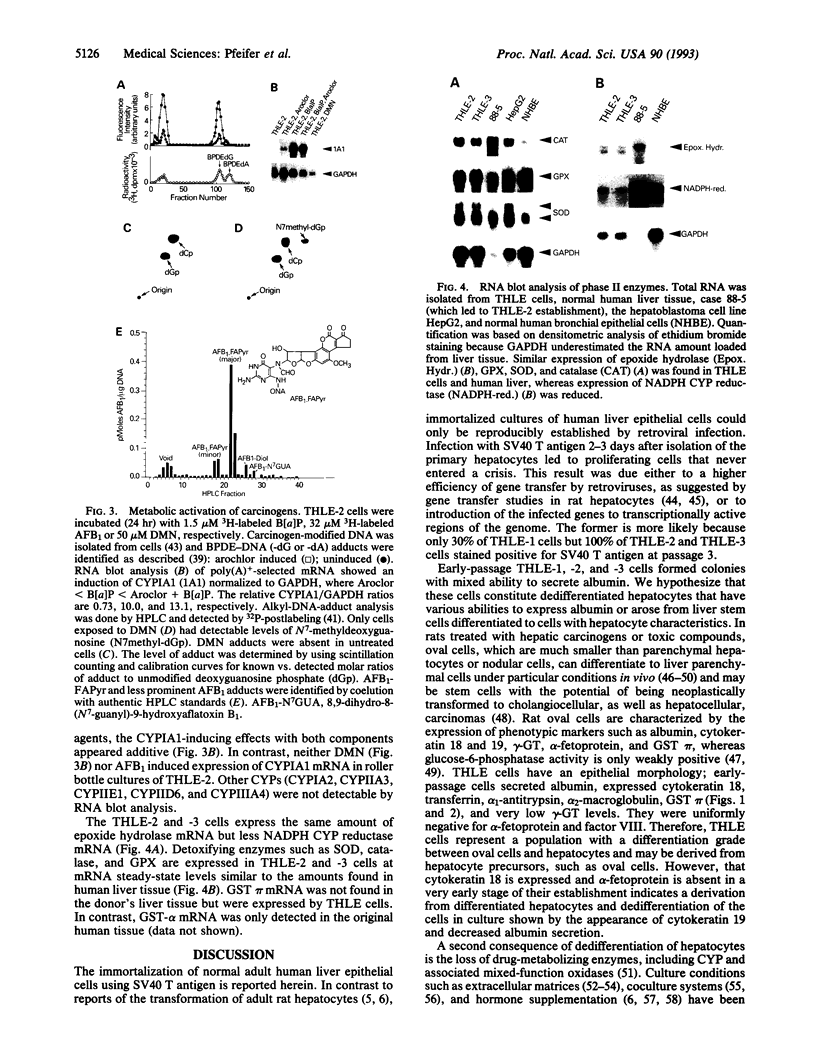
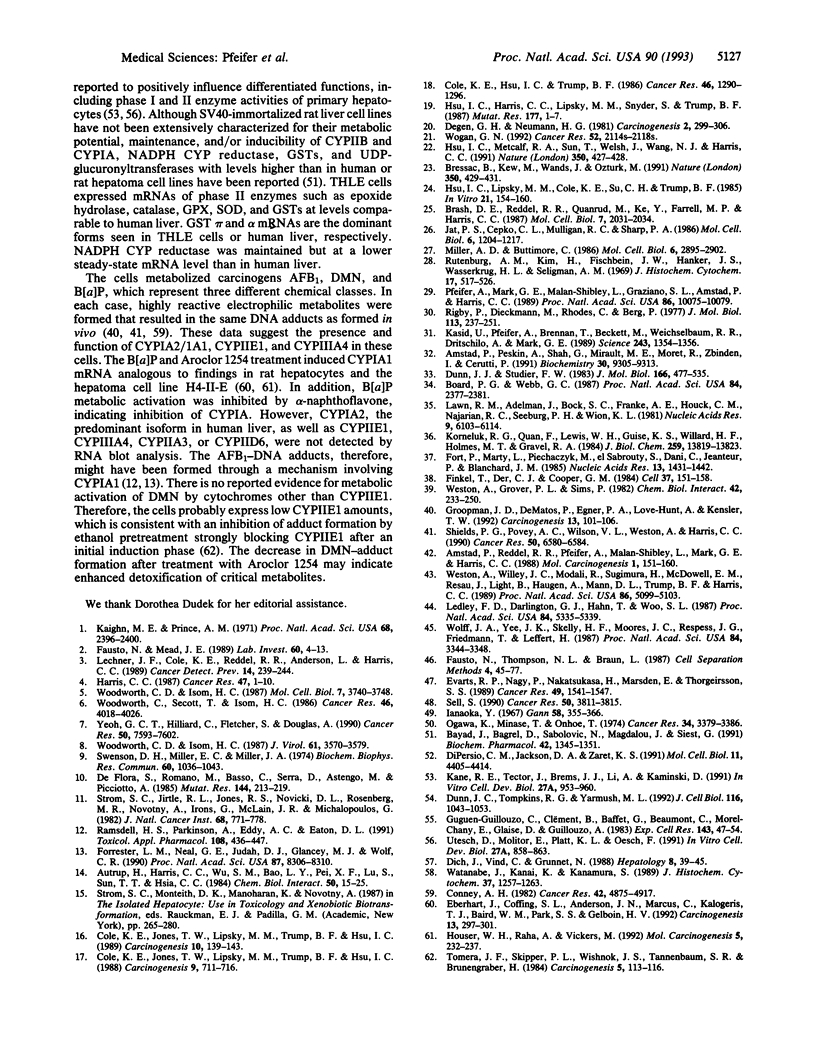
Images in this article
Selected References
These references are in PubMed. This may not be the complete list of references from this article.
- Amstad P., Reddel R. R., Pfeifer A., Malan-Shibley L., Mark G. E., 3rd, Harris C. C. Neoplastic transformation of a human bronchial epithelial cell line by a recombinant retrovirus encoding viral Harvey ras. Mol Carcinog. 1988;1(3):151–160. doi: 10.1002/mc.2940010303. [DOI] [PubMed] [Google Scholar]
- Autrup H., Harris C. C., Wu S. M., Bao L. Y., Pei X. F., Lu S., Sun T. T., Hsia C. C. Activation of chemical carcinogens by cultured human fetal liver, esophagus and stomach. Chem Biol Interact. 1984 Jun;50(1):15–25. doi: 10.1016/0009-2797(84)90128-5. [DOI] [PubMed] [Google Scholar]
- Bayad J., Bagrel D., Sabolovic N., Magdalou J., Siest G. Expression and regulation of drug metabolizing enzymes in an immortalized rat hepatocyte cell line. Biochem Pharmacol. 1991 Sep 12;42(7):1345–1351. doi: 10.1016/0006-2952(91)90444-a. [DOI] [PubMed] [Google Scholar]
- Board P. G., Webb G. C. Isolation of a cDNA clone and localization of human glutathione S-transferase 2 genes to chromosome band 6p12. Proc Natl Acad Sci U S A. 1987 Apr;84(8):2377–2381. doi: 10.1073/pnas.84.8.2377. [DOI] [PMC free article] [PubMed] [Google Scholar]
- Bressac B., Kew M., Wands J., Ozturk M. Selective G to T mutations of p53 gene in hepatocellular carcinoma from southern Africa. Nature. 1991 Apr 4;350(6317):429–431. doi: 10.1038/350429a0. [DOI] [PubMed] [Google Scholar]
- Cole K. E., Hsu I. C., Trump B. F. Comparative ultrastructural effects of aflatoxin B1 on mouse, rat, and human hepatocytes in primary culture. Cancer Res. 1986 Mar;46(3):1290–1296. [PubMed] [Google Scholar]
- Cole K. E., Jones T. W., Lipsky M. M., Trump B. F., Hsu I. C. Comparative effects of three carcinogens on human, rat and mouse hepatocytes. Carcinogenesis. 1989 Jan;10(1):139–143. doi: 10.1093/carcin/10.1.139. [DOI] [PubMed] [Google Scholar]
- Cole K. E., Jones T. W., Lipsky M. M., Trump B. F., Hsu I. C. In vitro binding of aflatoxin B1 and 2-acetylaminofluorene to rat, mouse and human hepatocyte DNA: the relationship of DNA binding to carcinogenicity. Carcinogenesis. 1988 May;9(5):711–716. doi: 10.1093/carcin/9.5.711. [DOI] [PubMed] [Google Scholar]
- Conney A. H. Induction of microsomal enzymes by foreign chemicals and carcinogenesis by polycyclic aromatic hydrocarbons: G. H. A. Clowes Memorial Lecture. Cancer Res. 1982 Dec;42(12):4875–4917. [PubMed] [Google Scholar]
- De Flora S., Romano M., Basso C., Serra D., Astengo M., Picciotto A. Metabolic activation of hepatocarcinogens in chronic hepatitis B. Mutat Res. 1985 Nov;144(3):213–219. doi: 10.1016/0165-7992(85)90143-5. [DOI] [PubMed] [Google Scholar]
- DiPersio C. M., Jackson D. A., Zaret K. S. The extracellular matrix coordinately modulates liver transcription factors and hepatocyte morphology. Mol Cell Biol. 1991 Sep;11(9):4405–4414. doi: 10.1128/mcb.11.9.4405. [DOI] [PMC free article] [PubMed] [Google Scholar]
- Dunn J. C., Tompkins R. G., Yarmush M. L. Hepatocytes in collagen sandwich: evidence for transcriptional and translational regulation. J Cell Biol. 1992 Feb;116(4):1043–1053. doi: 10.1083/jcb.116.4.1043. [DOI] [PMC free article] [PubMed] [Google Scholar]
- Eberhart J., Coffing S. L., Anderson J. N., Marcus C., Kalogeris T. J., Baird W. M., Park S. S., Gelboin H. V. The time-dependent increase in the binding of benzo[a]pyrene to DNA through (+)-anti-benzo[a]pyrene-7,8-diol-9,10-epoxide in primary rat hepatocyte cultures results from induction of cytochrome P450IA1 by benzo[a]pyrene treatment. Carcinogenesis. 1992 Feb;13(2):297–301. doi: 10.1093/carcin/13.2.297. [DOI] [PubMed] [Google Scholar]
- Evarts R. P., Nagy P., Nakatsukasa H., Marsden E., Thorgeirsson S. S. In vivo differentiation of rat liver oval cells into hepatocytes. Cancer Res. 1989 Mar 15;49(6):1541–1547. [PubMed] [Google Scholar]
- Forrester L. M., Neal G. E., Judah D. J., Glancey M. J., Wolf C. R. Evidence for involvement of multiple forms of cytochrome P-450 in aflatoxin B1 metabolism in human liver. Proc Natl Acad Sci U S A. 1990 Nov;87(21):8306–8310. doi: 10.1073/pnas.87.21.8306. [DOI] [PMC free article] [PubMed] [Google Scholar]
- Fort P., Marty L., Piechaczyk M., el Sabrouty S., Dani C., Jeanteur P., Blanchard J. M. Various rat adult tissues express only one major mRNA species from the glyceraldehyde-3-phosphate-dehydrogenase multigenic family. Nucleic Acids Res. 1985 Mar 11;13(5):1431–1442. doi: 10.1093/nar/13.5.1431. [DOI] [PMC free article] [PubMed] [Google Scholar]
- Groopman J. D., DeMatos P., Egner P. A., Love-Hunt A., Kensler T. W. Molecular dosimetry of urinary aflatoxin-N7-guanine and serum aflatoxin-albumin adducts predicts chemoprotection by 1,2-dithiole-3-thione in rats. Carcinogenesis. 1992 Jan;13(1):101–106. doi: 10.1093/carcin/13.1.101. [DOI] [PubMed] [Google Scholar]
- Guguen-Guillouzo C., Clément B., Baffet G., Beaumont C., Morel-Chany E., Glaise D., Guillouzo A. Maintenance and reversibility of active albumin secretion by adult rat hepatocytes co-cultured with another liver epithelial cell type. Exp Cell Res. 1983 Jan;143(1):47–54. doi: 10.1016/0014-4827(83)90107-6. [DOI] [PubMed] [Google Scholar]
- Houser W. H., Raha A., Vickers M. Induction of CYP1A1 gene expression in H4-II-E rat hepatoma cells by benzo[e]pyrene. Mol Carcinog. 1992;5(3):232–237. doi: 10.1002/mc.2940050310. [DOI] [PubMed] [Google Scholar]
- Hsu I. C., Lipsky M. M., Cole K. E., Su C. H., Trump B. F. Isolation and culture of hepatocytes from human liver of immediate autopsy. In Vitro Cell Dev Biol. 1985 Mar;21(3 Pt 1):154–160. doi: 10.1007/BF02621352. [DOI] [PubMed] [Google Scholar]
- Hsu I. C., Metcalf R. A., Sun T., Welsh J. A., Wang N. J., Harris C. C. Mutational hotspot in the p53 gene in human hepatocellular carcinomas. Nature. 1991 Apr 4;350(6317):427–428. doi: 10.1038/350427a0. [DOI] [PubMed] [Google Scholar]
- Jat P. S., Cepko C. L., Mulligan R. C., Sharp P. A. Recombinant retroviruses encoding simian virus 40 large T antigen and polyomavirus large and middle T antigens. Mol Cell Biol. 1986 Apr;6(4):1204–1217. doi: 10.1128/mcb.6.4.1204. [DOI] [PMC free article] [PubMed] [Google Scholar]
- Kaighn M. E., Prince A. M. Production of albumin and other serum proteins by clonal cultures of normal human liver. Proc Natl Acad Sci U S A. 1971 Oct;68(10):2396–2400. doi: 10.1073/pnas.68.10.2396. [DOI] [PMC free article] [PubMed] [Google Scholar]
- Kane R. E., Tector J., Brems J. J., Li A., Kaminski D. Sulfation and glucuronidation of acetaminophen by cultured hepatocytes reproducing in vivo sex-differences in conjugation on Matrigel and type 1 collagen. In Vitro Cell Dev Biol. 1991 Dec;27A(12):953–960. doi: 10.1007/BF02631123. [DOI] [PubMed] [Google Scholar]
- Lawn R. M., Adelman J., Bock S. C., Franke A. E., Houck C. M., Najarian R. C., Seeburg P. H., Wion K. L. The sequence of human serum albumin cDNA and its expression in E. coli. Nucleic Acids Res. 1981 Nov 25;9(22):6103–6114. doi: 10.1093/nar/9.22.6103. [DOI] [PMC free article] [PubMed] [Google Scholar]
- Lechner J. F., Cole K. E., Reddel R. R., Anderson L., Harris C. C. Replicative cultures of adult human and rhesus monkey liver epithelial cells. Cancer Detect Prev. 1989;14(2):239–244. [PubMed] [Google Scholar]
- Ledley F. D., Darlington G. J., Hahn T., Woo S. L. Retroviral gene transfer into primary hepatocytes: implications for genetic therapy of liver-specific functions. Proc Natl Acad Sci U S A. 1987 Aug;84(15):5335–5339. doi: 10.1073/pnas.84.15.5335. [DOI] [PMC free article] [PubMed] [Google Scholar]
- Pfeifer A. M., Mark G. E., 3rd, Malan-Shibley L., Graziano S., Amstad P., Harris C. C. Cooperation of c-raf-1 and c-myc protooncogenes in the neoplastic transformation of simian virus 40 large tumor antigen-immortalized human bronchial epithelial cells. Proc Natl Acad Sci U S A. 1989 Dec;86(24):10075–10079. doi: 10.1073/pnas.86.24.10075. [DOI] [PMC free article] [PubMed] [Google Scholar]
- Ramsdell H. S., Parkinson A., Eddy A. C., Eaton D. L. Bioactivation of aflatoxin B1 by human liver microsomes: role of cytochrome P450 IIIA enzymes. Toxicol Appl Pharmacol. 1991 May;108(3):436–447. doi: 10.1016/0041-008x(91)90090-2. [DOI] [PubMed] [Google Scholar]
- Rigby P. W., Dieckmann M., Rhodes C., Berg P. Labeling deoxyribonucleic acid to high specific activity in vitro by nick translation with DNA polymerase I. J Mol Biol. 1977 Jun 15;113(1):237–251. doi: 10.1016/0022-2836(77)90052-3. [DOI] [PubMed] [Google Scholar]
- Rutenburg A. M., Kim H., Fischbein J. W., Hanker J. S., Wasserkrug H. L., Seligman A. M. Histochemical and ultrastructural demonstration of gamma-glutamyl transpeptidase activity. J Histochem Cytochem. 1969 Aug;17(8):517–526. doi: 10.1177/17.8.517. [DOI] [PubMed] [Google Scholar]
- Sell S. Is there a liver stem cell? Cancer Res. 1990 Jul 1;50(13):3811–3815. [PubMed] [Google Scholar]
- Shields P. G., Povey A. C., Wilson V. L., Weston A., Harris C. C. Combined high-performance liquid chromatography/32P-postlabeling assay of N7-methyldeoxyguanosine. Cancer Res. 1990 Oct 15;50(20):6580–6584. [PubMed] [Google Scholar]
- Strom S. C., Jirtle R. L., Jones R. S., Novicki D. L., Rosenberg M. R., Novotny A., Irons G., McLain J. R., Michalopoulos G. Isolation, culture, and transplantation of human hepatocytes. J Natl Cancer Inst. 1982 May;68(5):771–778. [PubMed] [Google Scholar]
- Swenson D. H., Miller E. C., Miller J. A. Aflatoxin B1-2,3-oxide: evidence for its formation in rat liver in vivo and by human liver microsomes in vitro. Biochem Biophys Res Commun. 1974 Oct 8;60(3):1036–1043. doi: 10.1016/0006-291x(74)90417-3. [DOI] [PubMed] [Google Scholar]
- Tomera J. F., Skipper P. L., Wishnok J. S., Tannenbaum S. R., Brunengraber H. Inhibition of N-nitrosodimethylamine metabolism by ethanol and other inhibitors in the isolated perfused rat liver. Carcinogenesis. 1984 Jan;5(1):113–116. doi: 10.1093/carcin/5.1.113. [DOI] [PubMed] [Google Scholar]
- Utesch D., Molitor E., Platt K. L., Oesch F. Differential stabilization of cytochrome P-450 isoenzymes in primary cultures of adult rat liver parenchymal cells. In Vitro Cell Dev Biol. 1991 Nov;27A(11):858–863. doi: 10.1007/BF02630988. [DOI] [PubMed] [Google Scholar]
- Watanabe J., Kanai K., Kanamura S. A new microphotometric method for measurement of cytochrome P-450 in sections of liver. J Histochem Cytochem. 1989 Aug;37(8):1257–1263. doi: 10.1177/37.8.2754255. [DOI] [PubMed] [Google Scholar]
- Weston A., Grover P. L., Sims P. Metabolism and activation of benzo[a]pyrene by mouse and rat skin in short-term organ culture and in vivo. Chem Biol Interact. 1982 Nov;42(2):233–250. doi: 10.1016/0009-2797(82)90135-1. [DOI] [PubMed] [Google Scholar]
- Weston A., Willey J. C., Modali R., Sugimura H., McDowell E. M., Resau J., Light B., Haugen A., Mann D. L., Trump B. F. Differential DNA sequence deletions from chromosomes 3, 11, 13, and 17 in squamous-cell carcinoma, large-cell carcinoma, and adenocarcinoma of the human lung. Proc Natl Acad Sci U S A. 1989 Jul;86(13):5099–5103. doi: 10.1073/pnas.86.13.5099. [DOI] [PMC free article] [PubMed] [Google Scholar]
- Wolff J. A., Yee J. K., Skelly H. F., Moores J. C., Respess J. G., Friedmann T., Leffert H. Expression of retrovirally transduced genes in primary cultures of adult rat hepatocytes. Proc Natl Acad Sci U S A. 1987 May;84(10):3344–3348. doi: 10.1073/pnas.84.10.3344. [DOI] [PMC free article] [PubMed] [Google Scholar]
- Woodworth C., Secott T., Isom H. C. Transformation of rat hepatocytes by transfection with simian virus 40 DNA to yield proliferating differentiated cells. Cancer Res. 1986 Aug;46(8):4018–4026. [PubMed] [Google Scholar]
- Yeoh G. C., Hilliard C., Fletcher S., Douglas A. Gene expression in clonally derived cell lines produced by in vitro transformation of rat fetal hepatocytes: isolation of cell lines which retain liver-specific markers. Cancer Res. 1990 Dec 1;50(23):7593–7602. [PubMed] [Google Scholar]





